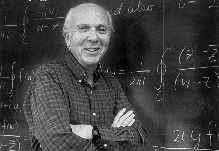Professor Stresses the Language of Math
by Susan Gaidos, University News Service
 Imagine asking for directions and being told, "I know how to get
there, but I can't describe it." Award-winning mathematics
professor Justin J. Price found a similar situation in his
classroom when he asked students to describe various
mathematical processes. For many, the task of interpreting
mathematical language was next to impossible.
Imagine asking for directions and being told, "I know how to get
there, but I can't describe it." Award-winning mathematics
professor Justin J. Price found a similar situation in his
classroom when he asked students to describe various
mathematical processes. For many, the task of interpreting
mathematical language was next to impossible.
"There's a lot of truth in saying, 'If you can't explain it, you
don't understand it,'" Professor Price says. He devised a course
to boost students' mathematics and language skills by requiring
them to write explanations for mathematical operations. Price
says that writing forces students to think deeply about
mathematical processes and express themselves precisely.
Asking students to write about mathematics seemed only
logical, Professor Price says, noting that in all other disciplines
of study, writing is required in some form, such as term papers
or lab reports.
"Can you imagine a student who has taken eight years of
French and still cannot write or speak a simple sentence?" he
says. "We have simply neglected an important part of students'
education. We pay the penalty in frustration when we find our
students practically illiterate in the language of mathematics. If
my students parachuted into Algebraland, most of them would
starve because they could not speak the language."
Professor Price notes that the language of mathematics
includes not only numbers and symbols, but also words that
describe with precision the types of procedures used to solve
mathematical problems. "Using words such as 'multiply' rather
than 'times' or 'inverse' rather than 'opposite' helps students
focus more clearly on what they are doing," he says. In his
class, Professor Price instructs students to describe solutions so
that readers who are not familiar with mathematics can learn
from their explanations. He also requires students to follow the
rules of grammar and punctuation, and encourages them to strike
a balance between words and mathematical symbols. "This
process initially requires more thought and time on the part of
the students, but it helps make them think more clearly,"
Professor Price says.
He has used his mathematical-writing approach in a wide
range of mathematics courses at Purdue, from freshman calculus
to graduate courses in real analysis, and particularly, in a course
he developed for prospective teachers. In recent years, Professor
Price has become involved in teacher training, working to help
school teachers nationwide adopt his approach for their
classrooms.
One of the benefits of the method is that it can be used to
increase mathematical performance at all grade levels and for all
students, according to department head Leonard Lipshitz.
"Teachers often adopt new teaching approaches to reach students
who are having trouble learning new concepts or procedures," he
says. "This approach, however, has proven to be beneficial to
top students as well, as it helps them to think in a logical
manner, thus increasing their understanding of the process."
His attentive attitude toward teaching has not gone
unnoticed. After being named by students as one of the top 10
teachers in the School of Science in 1978, 1980 and 1982, Price
was named Outstanding Teacher in the School in 1986. In the
fall of 1993, Professor Price was selected by the Mathematical
Association of America to receive the organization's 1993 award
for distinguished college or university teaching.
"I am very grateful to the Association for this award," says
Professor Price. "It is a particular honor to be one of three
chosen from such a distinguished field of sectional awardees. I
have had many satisfactions in teaching: seeing a student's eyes
suddenly light up with understanding, imparting enthusiasm for
the subject and a desire to learn more, convincing future teachers
that math is more than a collection of rules. But these were
private awards; to be cited publicly is truly wonderful."
[Previous Article |
Next Article]
 Imagine asking for directions and being told, "I know how to get
there, but I can't describe it." Award-winning mathematics
professor Justin J. Price found a similar situation in his
classroom when he asked students to describe various
mathematical processes. For many, the task of interpreting
mathematical language was next to impossible.
Imagine asking for directions and being told, "I know how to get
there, but I can't describe it." Award-winning mathematics
professor Justin J. Price found a similar situation in his
classroom when he asked students to describe various
mathematical processes. For many, the task of interpreting
mathematical language was next to impossible.